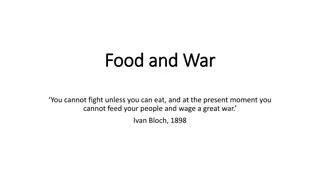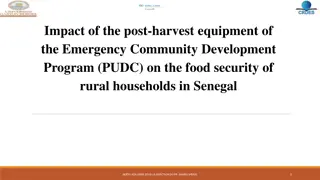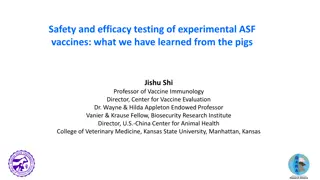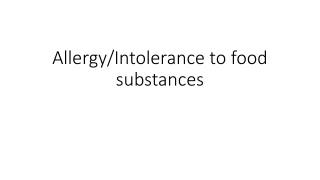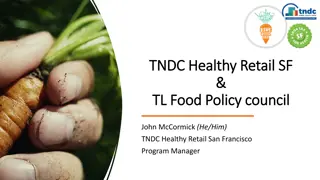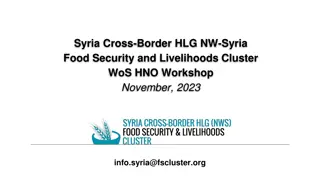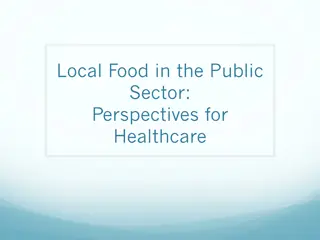A Risk Factor Study on Food Establishments in Kansas
Explore a risk factor study conducted on food establishments in Kansas by Crystal Futrell, a Kansas State University MPH candidate specializing in Food Safety and Biosecurity. The study delves into the history of the Kansas Department of Agriculture, its various programs related to food safety and lodging, and the pivotal role it plays in regulating food production facilities. Highlighting the critical importance of food safety as a public health concern, the study underscores the impact of foodborne illnesses in the US, emphasizing the economic and health implications associated with such incidents.
Download Presentation
Please find below an Image/Link to download the presentation.
The content on the website is provided AS IS for your information and personal use only. It may not be sold, licensed, or shared on other websites without obtaining consent from the author. Download presentation by click this link. If you encounter any issues during the download, it is possible that the publisher has removed the file from their server.
Presentation Transcript
A Risk Factor Study on Food Establishments in Kansas Crystal Futrell Kansas State University MPH Candidate/Food Safety & Biosecurity
Topics: Field Experience History of KDA Risk Factory Study Standard 9 Applied Coursework Competencies
Virtual Field Experience Kansas Depart of Ag (KDA) Preceptor: Adam Inman Food Safety & Lodging Program Assistant Program Manager
History of Kansas Department of Agriculture Nation s 1st state-run ag department Started as the Kansas Agriculture Society when KS still a territory Farmers regularly met to discuss land claims, share best practices County/State fairs were gathering events for farmers March 5, 1862, society became KDA This photograph shows men harvesting wheat with a steam tractor, thresher, and horse-drawn water wagon in a field in Seward County, Kansas. (Between 1891 and 1912)
History of Kansas Department of Agriculture Agricultural Laboratory Agricultural Marketing Dairy and Feed Safety Program Division of Animal Health Division of Conservation Food Safety & Lodging Program Grain Warehouse Inspection Program Meat & Poultry Inspection Program Pesticide and Fertilizer Program Plant Protection & Weed Control Program Division of Water Resources Weights & Measures Program
KDAs Food Safety & Lodging Program State s regulatory arm for food production and public service facilities Inspects: Egg production farms Senior meal sites Mobile food units Lodging facilities Food wholesalers Food warehouses Food processors Food manufacturers Restaurants Grocery stores Convenience stores Schools
Food Safety is a Public Health Concern Each year in the US, foodborne illnesses: Affect 48 million people Result in 128,000 hospitalizations Cause 3,000 deaths Carry an economic burden of $15.5 billion dollars
Risk Factor Study Standard 9 Report Measure the success in reducing the occurrence of foodborne illness risk factors
Risk Factor Study Standard 9 Report Measure the success in reducing the occurrence of foodborne illness risk factors
Risk Factor Study Standard 9 Report Measure the success in reducing the occurrence of foodborne illness risk factors
Risk Factor Study Top 5 Foodborne Illness Risk Factors: 1. Poor personal hygiene (leading cause of foodborne illness) 2. Improper holding temperatures 3. Improper cooking temperatures 4. Food from unsafe sources 5. Contaminated equipment/cross-contamination
Risk Factor Study Top 5 Foodborne Illness Risk Factors: 1. Poor personal hygiene (leading cause of foodborne illness) 2. Improper holding temperatures 3. Improper cooking temperatures 4. Food from unsafe sources 5. Contaminated equipment/cross-contamination
Organize data Analyze data
Organize data Analyze data Interpret data
Organize data Analyze data Interpret data Make suggestions for interventional strategies
Organize data Analyze data Interpret data Make suggestions for interventional strategies Standard 9 Report
Products Developed Inspection Data Sheet (Excel Workbook) Inspection Analysis Report Standard 9 Report Standard 9 PowerPoint Presentation
3. Proper Use of Reporting, Restriction & Exclusion ~5730 Restaurants/Year ~1292 Food Retail Stores/Year 100% 100% 80% 80% 60% 60% 40% 40% 20% 20% 0% 0% 2016 2017 2018 2019 2016 2017 2018 2019 IN OUT N.A. N.O. IN OUT N.A. N.O. ~2077 Schools/Year 546 Satellite Schools/Year 100% 100% 80% 80% 60% 60% 40% 40% 20% 20% 0% 0% 2016 2017 2018 2019 2016 2017 2018 2019 IN OUT N.A. N.O. IN OUT N.A. N.O.
Receiving safe food is first step is ensuring food is safe Understandable that inspections and receiving times don t always line up But this activity consistently unobserved over 90% each year for restaurants, retail and schools 10. Food Received at Proper Temperatures


































